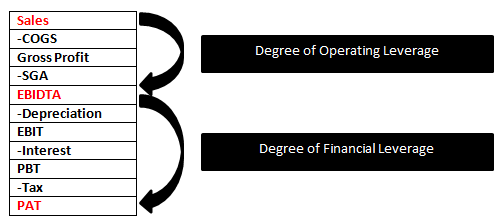Most firms use both operating leverage and capital leverage to some
extent. In today’s business world it is almost impossible to run a
business without having some degree of automation and mechanization
(operating leverage). It is also not possible to grow at an adequate
speed unless the company is taking advantage of borrowed money.
However, the degree to which a company uses operating leverage and
financial leverage can be different. Some companies use more financial
leverage than operating leverage while other use more operating
leverage. This creates a challenging scenario whereas an analyst has to
interpret the different degrees of riskiness of companies with different
cost and capital structures. The degree of combined leverage (DCL)
makes it possible to do this.
Formula
- Degree of Combined Leverage = %Change in EPS / %Change in Sales
- Degree of Combined Leverage = Degree of Operating Leverage * Degree of Financial Leverage
Example

PAT / Number of Shares = Earnings per Share (EPS)
Therefore if operating leverage of a firm= 1.4 whereas financial
leverage = 2, then the degree of combined leverage equals 1.4*2 = 2.8
Interpretation
Degree of operating leverage shows how a change in sales affects the
EBIDTA of the firm. Whereas degree of financial leverage shows how a
change in EBIDTA affects the EPS of the firm. Combining the two analysts
can predict how a change in sales is likely to magnify the gains or
losses to the EPS.


